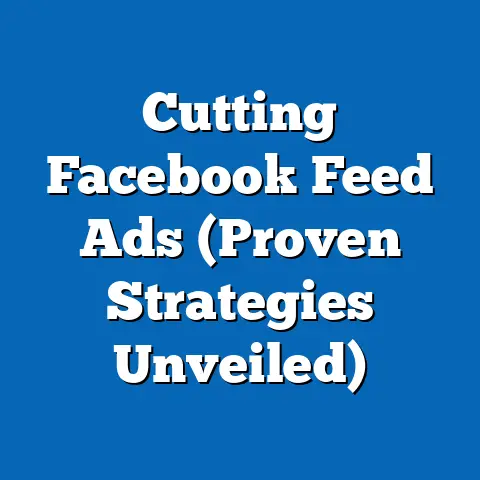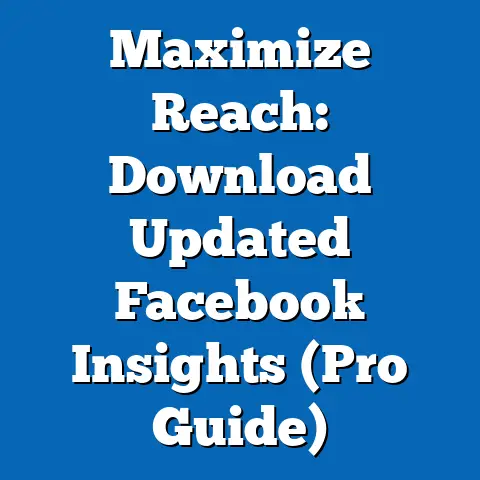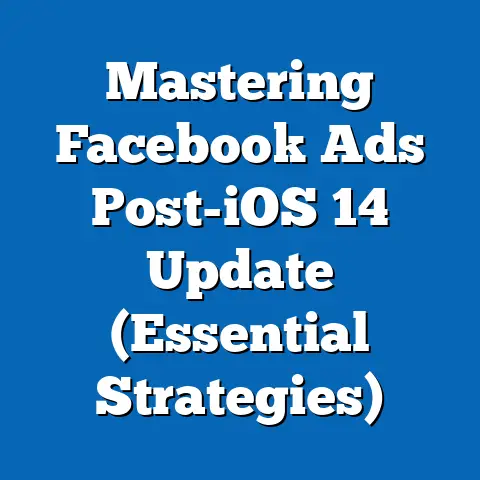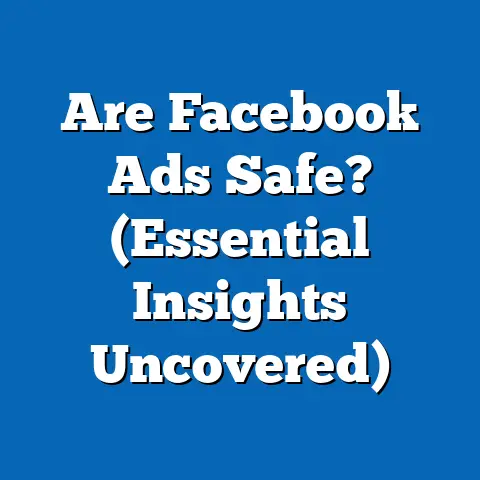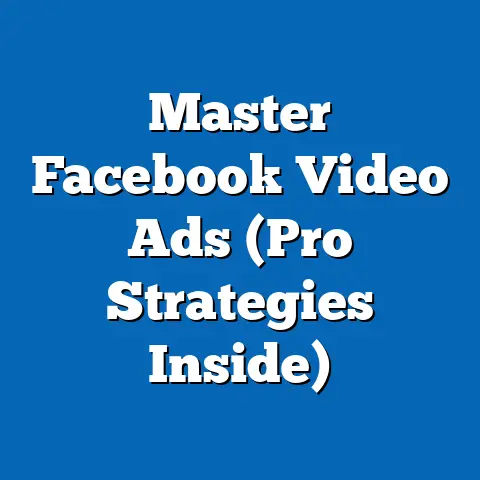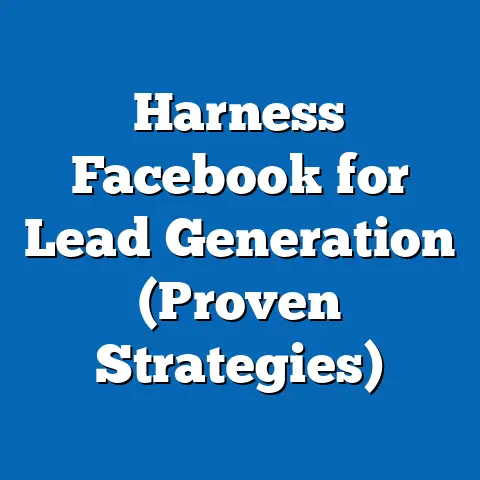Master Ads with Facebook’s Icon (Essential Guide)
Facebook is a powerhouse. As a digital marketing expert, I’ve seen firsthand how its advertising platform can transform businesses of all sizes. What truly sets Facebook apart is its incredible customizability. It’s not a one-size-fits-all solution; you can really tailor your marketing strategies to meet the diverse needs of your audience. This level of personalization can be a game-changer, leading to better engagement, higher conversion rates, and ultimately, a stronger ROI.
In this guide, I’m going to walk you through the essentials of mastering Facebook ads. We’ll explore the different ad types, delve into the power of targeting, discuss crafting compelling content, demystify budgeting and bidding strategies, and show you how to analyze and optimize your ad performance. My goal is to equip you with the knowledge and actionable steps you need to elevate your Facebook advertising efforts and achieve your business goals. Let’s dive in!
Understanding Facebook Ads
Facebook offers a diverse range of ad formats, each with its own unique features and benefits. Understanding these different types is the first step to creating effective campaigns. Let’s take a closer look:
-
Image Ads: These are the simplest form of Facebook ads, featuring a single image and accompanying text. They are great for showcasing products, services, or brand messaging in a visually appealing way. I’ve found that high-quality, relevant images are crucial for capturing attention in the busy newsfeed.
-
Video Ads: Video ads are incredibly engaging and can be used to tell stories, demonstrate products, or share testimonials. They tend to perform well because they capture attention quickly and allow for more in-depth storytelling than static images. From my experience, shorter videos (around 15-30 seconds) tend to perform best on mobile.
-
Carousel Ads: This format allows you to showcase multiple images or videos in a single ad, each with its own headline, description, and link. Carousel ads are perfect for highlighting different features of a product, showcasing a product line, or telling a story in a sequence. I used carousel ads to promote a clothing line, and the ability to showcase different outfits in one ad drastically increased click-through rates.
-
Slideshow Ads: Slideshow ads combine a series of images or videos into a looping video format. They are a cost-effective way to create engaging video content, especially if you don’t have the resources to produce high-quality video footage.
-
Collection Ads: These ads are designed for mobile shopping and feature a cover image or video followed by several product images. When a user clicks on the ad, they are taken to a full-screen experience where they can browse and purchase products. I’ve seen collection ads work wonders for e-commerce businesses, especially when showcasing a catalog of products.
Image Ads: These are the simplest form of Facebook ads, featuring a single image and accompanying text. They are great for showcasing products, services, or brand messaging in a visually appealing way. I’ve found that high-quality, relevant images are crucial for capturing attention in the busy newsfeed.
Video Ads: Video ads are incredibly engaging and can be used to tell stories, demonstrate products, or share testimonials. They tend to perform well because they capture attention quickly and allow for more in-depth storytelling than static images. From my experience, shorter videos (around 15-30 seconds) tend to perform best on mobile.
Carousel Ads: This format allows you to showcase multiple images or videos in a single ad, each with its own headline, description, and link. Carousel ads are perfect for highlighting different features of a product, showcasing a product line, or telling a story in a sequence. I used carousel ads to promote a clothing line, and the ability to showcase different outfits in one ad drastically increased click-through rates.
Slideshow Ads: Slideshow ads combine a series of images or videos into a looping video format. They are a cost-effective way to create engaging video content, especially if you don’t have the resources to produce high-quality video footage.
Collection Ads: These ads are designed for mobile shopping and feature a cover image or video followed by several product images. When a user clicks on the ad, they are taken to a full-screen experience where they can browse and purchase products. I’ve seen collection ads work wonders for e-commerce businesses, especially when showcasing a catalog of products.
Each of these ad types can be customized to fit specific marketing goals. For example, if you’re looking to drive website traffic, you might focus on image or video ads with a clear call-to-action. If you’re aiming to generate leads, you could use lead ads, which allow users to submit their information directly within the Facebook platform. If you want to increase app installs, you can use app install ads.
Real-World Example: A local bakery wanted to increase its online orders. They ran a carousel ad showcasing their most popular pastries, each with a link to the corresponding product page on their website. This resulted in a 30% increase in online orders within the first month.
According to a recent study, video ads on Facebook have a 1200% higher share rate than text and image content combined. This highlights the power of video in capturing attention and driving engagement.
Key Takeaway: Understanding the different types of Facebook ads and how they can be customized is essential for creating effective campaigns. Experiment with different formats to see what resonates best with your target audience.
The Power of Targeting and Custom Audiences
Facebook’s targeting options are incredibly granular, allowing you to reach specific audiences based on a wide range of criteria. This is where the true power of Facebook advertising lies.
-
Demographic Targeting: You can target users based on age, gender, education, relationship status, job title, and more. This is useful for reaching broad audiences with specific characteristics.
-
Interest Targeting: This allows you to target users based on their interests, hobbies, and the pages they’ve liked on Facebook. For example, you could target users interested in “hiking” or “organic food.”
-
Behavior Targeting: This is based on users’ past behavior on Facebook and other websites. You can target users who have recently purchased a product, traveled internationally, or attended a specific event.
-
Location Targeting: You can target users based on their location, from specific countries and cities to zip codes and even neighborhoods. This is particularly useful for local businesses looking to reach customers in their area.
Demographic Targeting: You can target users based on age, gender, education, relationship status, job title, and more. This is useful for reaching broad audiences with specific characteristics.
Interest Targeting: This allows you to target users based on their interests, hobbies, and the pages they’ve liked on Facebook. For example, you could target users interested in “hiking” or “organic food.”
Behavior Targeting: This is based on users’ past behavior on Facebook and other websites. You can target users who have recently purchased a product, traveled internationally, or attended a specific event.
Location Targeting: You can target users based on their location, from specific countries and cities to zip codes and even neighborhoods. This is particularly useful for local businesses looking to reach customers in their area.
But the real magic happens when you start using Custom Audiences. These allow you to upload your own customer data (email lists, phone numbers) or create audiences based on website traffic or engagement on Facebook.
-
Customer List Audiences: Upload your existing customer list to target your current customers with specific offers or promotions. I’ve used this to re-engage inactive customers with a special discount, resulting in a significant boost in sales.
-
Website Custom Audiences: Target users who have visited your website or specific pages on your website. This is incredibly powerful for retargeting users who have shown interest in your products or services. For example, you can show ads to users who added items to their cart but didn’t complete the purchase.
-
Lookalike Audiences: Create audiences that are similar to your existing customers or website visitors. Facebook analyzes the characteristics of your source audience and finds users who share similar traits. This is a great way to expand your reach and find new customers who are likely to be interested in your products or services. I’ve found that Lookalike Audiences based on high-value customers tend to perform exceptionally well.
Customer List Audiences: Upload your existing customer list to target your current customers with specific offers or promotions. I’ve used this to re-engage inactive customers with a special discount, resulting in a significant boost in sales.
Website Custom Audiences: Target users who have visited your website or specific pages on your website. This is incredibly powerful for retargeting users who have shown interest in your products or services. For example, you can show ads to users who added items to their cart but didn’t complete the purchase.
Lookalike Audiences: Create audiences that are similar to your existing customers or website visitors. Facebook analyzes the characteristics of your source audience and finds users who share similar traits. This is a great way to expand your reach and find new customers who are likely to be interested in your products or services. I’ve found that Lookalike Audiences based on high-value customers tend to perform exceptionally well.
Real-World Example: A fitness studio used Facebook’s targeting options to reach potential customers in their local area. They targeted users interested in “fitness,” “yoga,” and “healthy eating” who lived within a 5-mile radius of their studio. They also created a Website Custom Audience to retarget users who had visited their website but hadn’t signed up for a class. This resulted in a 40% increase in new memberships within the first three months.
Key Takeaway: Precise targeting is crucial for maximizing the effectiveness of your Facebook ads. Take the time to understand your target audience and use Facebook’s targeting options to reach them with relevant and engaging ads. Custom Audiences are a game-changer, allowing you to leverage your existing customer data and find new customers who are likely to be interested in your products or services.
Crafting Compelling Ad Content
No matter how precise your targeting is, your ads will fall flat if the content isn’t compelling. Creating eye-catching visuals and persuasive ad copy is essential for capturing attention and driving results.
-
Visuals: Use high-quality images or videos that are relevant to your target audience and your offer. Avoid using stock photos that look generic. Instead, opt for authentic images that showcase your products or services in a real-world setting. For video ads, make sure the first few seconds are attention-grabbing.
-
Ad Copy: Your ad copy should be clear, concise, and persuasive. Highlight the benefits of your product or service and address the pain points of your target audience. Use strong calls-to-action that encourage users to take the desired action, such as “Shop Now,” “Learn More,” or “Sign Up.”
-
A/B Testing: Don’t be afraid to experiment with different ad formats and messages. A/B testing allows you to compare different versions of your ads to see which ones perform best. Test different headlines, descriptions, images, and calls-to-action.
Visuals: Use high-quality images or videos that are relevant to your target audience and your offer. Avoid using stock photos that look generic. Instead, opt for authentic images that showcase your products or services in a real-world setting. For video ads, make sure the first few seconds are attention-grabbing.
Ad Copy: Your ad copy should be clear, concise, and persuasive. Highlight the benefits of your product or service and address the pain points of your target audience. Use strong calls-to-action that encourage users to take the desired action, such as “Shop Now,” “Learn More,” or “Sign Up.”
A/B Testing: Don’t be afraid to experiment with different ad formats and messages. A/B testing allows you to compare different versions of your ads to see which ones perform best. Test different headlines, descriptions, images, and calls-to-action.
Best Practices for Writing Headlines:
- Keep them short and to the point (ideally under 25 characters).
- Highlight the main benefit of your offer.
- Use strong keywords that are relevant to your target audience.
- Include a call-to-action.
Best Practices for Writing Descriptions:
- Expand on the headline and provide more details about your offer.
- Address the pain points of your target audience.
- Use persuasive language that encourages users to take action.
- Include a sense of urgency or scarcity (e.g., “Limited Time Offer”).
Best Practices for Calls-to-Action:
- Use strong action verbs (e.g., “Shop,” “Learn,” “Sign Up”).
- Make them clear and concise.
- Ensure they are relevant to your offer.
- Test different calls-to-action to see which ones perform best.
Real-World Example: An e-commerce store selling handmade jewelry ran two versions of the same ad. One version had a headline that read “Shop Our New Jewelry Collection,” while the other had a headline that read “Handmade Jewelry That Makes a Statement.” The second version, which focused on the benefit of the jewelry, had a 40% higher click-through rate.
Key Takeaway: Compelling ad content is crucial for capturing attention and driving results. Use high-quality visuals, persuasive ad copy, and strong calls-to-action. Don’t be afraid to A/B test different ad formats and messages to see what works best for your target audience.
Budgeting and Bidding Strategies
Setting a realistic budget and choosing the right bidding strategy are essential for maximizing your return on investment. Facebook offers a range of budgeting options to suit different needs and objectives.
-
Daily Budget: Set a fixed amount that you’re willing to spend each day on your ads. This is a good option if you want to control your spending and ensure that you don’t exceed your budget.
-
Lifetime Budget: Set a fixed amount that you’re willing to spend over the entire duration of your campaign. This is a good option if you have a specific budget in mind and want to ensure that you don’t exceed it.
-
Bid Strategies: Facebook offers several bidding strategies to help you optimize your ad spend.
-
Lowest Cost: Facebook automatically bids to get you the most results for your budget. This is a good option if you’re new to Facebook advertising or if you want to maximize your reach.
-
Cost Cap: Set a target cost per result, and Facebook will try to get you results at or below that cost. This is a good option if you have a specific cost per result in mind.
-
Target Cost: Similar to Cost Cap, but Facebook will try to get you results as close to your target cost as possible.
-
Bid Cap: Set a maximum bid that you’re willing to pay for each result. This is a good option if you want to control your bidding and ensure that you don’t overpay for results.
-
Daily Budget: Set a fixed amount that you’re willing to spend each day on your ads. This is a good option if you want to control your spending and ensure that you don’t exceed your budget.
Lifetime Budget: Set a fixed amount that you’re willing to spend over the entire duration of your campaign. This is a good option if you have a specific budget in mind and want to ensure that you don’t exceed it.
Bid Strategies: Facebook offers several bidding strategies to help you optimize your ad spend.
-
Lowest Cost: Facebook automatically bids to get you the most results for your budget. This is a good option if you’re new to Facebook advertising or if you want to maximize your reach.
-
Cost Cap: Set a target cost per result, and Facebook will try to get you results at or below that cost. This is a good option if you have a specific cost per result in mind.
-
Target Cost: Similar to Cost Cap, but Facebook will try to get you results as close to your target cost as possible.
-
Bid Cap: Set a maximum bid that you’re willing to pay for each result. This is a good option if you want to control your bidding and ensure that you don’t overpay for results.
Lowest Cost: Facebook automatically bids to get you the most results for your budget. This is a good option if you’re new to Facebook advertising or if you want to maximize your reach.
Cost Cap: Set a target cost per result, and Facebook will try to get you results at or below that cost. This is a good option if you have a specific cost per result in mind.
Target Cost: Similar to Cost Cap, but Facebook will try to get you results as close to your target cost as possible.
Bid Cap: Set a maximum bid that you’re willing to pay for each result. This is a good option if you want to control your bidding and ensure that you don’t overpay for results.
When setting your budget, consider your advertising objectives and expected outcomes. If you’re looking to generate leads, you’ll need to budget more than if you’re simply trying to increase brand awareness. Also, consider the size of your target audience and the competitiveness of your industry.
It’s important to monitor your ad spend and adjust your bids as needed to optimize performance. Facebook’s ad auction system is dynamic, and bids can fluctuate based on competition and other factors.
Real-World Example: A small business selling handmade candles wanted to increase their online sales. They started with a daily budget of $20 and the “Lowest Cost” bidding strategy. After a week, they analyzed their ad performance and saw that their cost per click was higher than they expected. They switched to the “Cost Cap” bidding strategy and set a target cost per click. This resulted in a significant decrease in their cost per click and an increase in their online sales.
Key Takeaway: Setting a realistic budget and choosing the right bidding strategy are crucial for maximizing your return on investment. Monitor your ad spend and adjust your bids as needed to optimize performance.
Analyzing and Optimizing Ad Performance
Facebook Ads Manager is a powerful tool for tracking ad performance metrics and making informed decisions to refine your campaigns. Key performance indicators (KPIs) to track include:
-
Click-Through Rate (CTR): The percentage of users who see your ad and click on it. A high CTR indicates that your ad is relevant and engaging to your target audience.
-
Conversion Rate: The percentage of users who click on your ad and complete a desired action, such as making a purchase or filling out a form. A high conversion rate indicates that your landing page is effective and that your offer is compelling.
-
Cost Per Click (CPC): The amount you pay each time someone clicks on your ad. A low CPC indicates that your ads are efficient and that you’re not overpaying for traffic.
-
Cost Per Acquisition (CPA): The amount you pay for each conversion. A low CPA indicates that your ads are effective at driving conversions and that you’re getting a good return on your investment.
-
Return on Ad Spend (ROAS): The amount of revenue you generate for every dollar you spend on advertising. A high ROAS indicates that your ads are profitable and that you’re getting a good return on your investment.
Click-Through Rate (CTR): The percentage of users who see your ad and click on it. A high CTR indicates that your ad is relevant and engaging to your target audience.
Conversion Rate: The percentage of users who click on your ad and complete a desired action, such as making a purchase or filling out a form. A high conversion rate indicates that your landing page is effective and that your offer is compelling.
Cost Per Click (CPC): The amount you pay each time someone clicks on your ad. A low CPC indicates that your ads are efficient and that you’re not overpaying for traffic.
Cost Per Acquisition (CPA): The amount you pay for each conversion. A low CPA indicates that your ads are effective at driving conversions and that you’re getting a good return on your investment.
Return on Ad Spend (ROAS): The amount of revenue you generate for every dollar you spend on advertising. A high ROAS indicates that your ads are profitable and that you’re getting a good return on your investment.
By tracking these KPIs, you can identify areas for improvement and make data-driven decisions to optimize your ad campaigns. For example, if your CTR is low, you might need to improve your ad copy or visuals. If your conversion rate is low, you might need to optimize your landing page or improve your offer.
Facebook also offers a range of analytics tools to help you understand your audience and track your ad performance. These tools include:
-
Facebook Pixel: A piece of code that you install on your website to track conversions and other actions.
-
Facebook Analytics: A comprehensive analytics platform that provides insights into your audience, your website traffic, and your ad performance.
Facebook Pixel: A piece of code that you install on your website to track conversions and other actions.
Facebook Analytics: A comprehensive analytics platform that provides insights into your audience, your website traffic, and your ad performance.
Real-World Example: A fashion retailer was running a Facebook ad campaign to promote their new summer collection. They were tracking their ad performance using Facebook Ads Manager and noticed that their CTR was low. They analyzed their ad copy and visuals and realized that they weren’t effectively showcasing the benefits of their new collection. They updated their ad copy and visuals to highlight the unique features of their summer collection and saw a significant increase in their CTR.
Key Takeaway: Analyzing and optimizing your ad performance is crucial for maximizing your return on investment. Use Facebook Ads Manager and Facebook Analytics to track your KPIs, identify areas for improvement, and make data-driven decisions to refine your campaigns.
Conclusion
Mastering Facebook ads requires a deep understanding of the platform’s capabilities and a willingness to experiment and optimize. The customizability of Facebook ads allows you to tailor your marketing strategies to meet the diverse needs of your audience, leading to better engagement and conversion rates.
Remember to:
- Understand the different types of Facebook ads and how they can be customized.
- Leverage Facebook’s targeting options to reach specific audiences.
- Craft compelling ad content that captures attention and drives results.
- Set a realistic budget and choose the right bidding strategy.
- Analyze and optimize your ad performance using Facebook Ads Manager.
By applying these strategies, you can unlock the full potential of Facebook advertising and achieve your business goals. Don’t be afraid to experiment and test different approaches to see what works best for your target audience. The possibilities are endless, and the potential for growth and success is within your reach. Embrace the platform’s capabilities and start mastering your Facebook advertising efforts today!
Now, I’d love to hear from you! What are your biggest challenges with Facebook ads? What strategies have worked best for you? Share your experiences, ask questions, or seek further information in the comments section below. Let’s learn and grow together!

